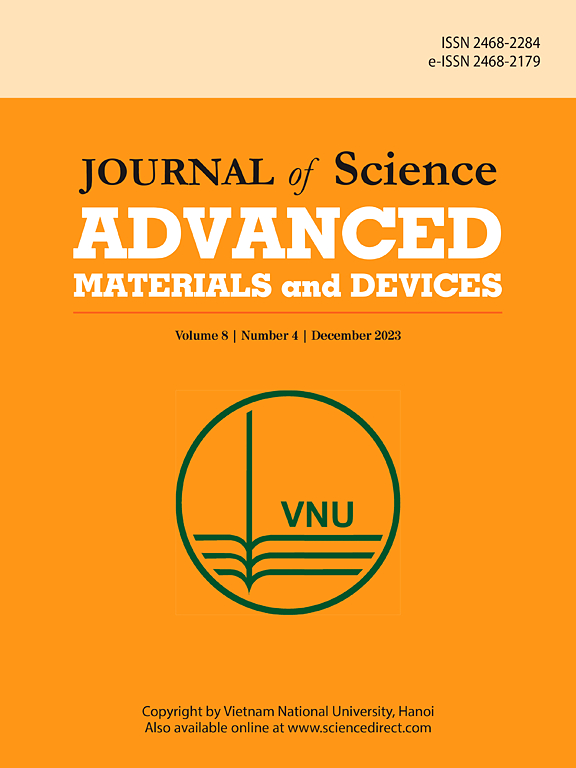Fabrication of highly efficient quartz crystal microbalance ammonia sensor based on Cu-BTC nanocomposites
IF 6.7
3区 材料科学
Q1 MATERIALS SCIENCE, MULTIDISCIPLINARY
Journal of Science: Advanced Materials and Devices
Pub Date : 2025-01-16
DOI:10.1016/j.jsamd.2025.100850
引用次数: 0
Abstract
Today, the measurement of ammonia gas as a corrosive and irritating gas in the environment is very crucial. Therefore, a simple and efficient method for its detection is very important. A quartz crystal microbalance (QCM) gas sensor modified with porous nanomaterials is proposed as a new device with high performance at ambient temperature. Metal-organic frameworks (MOFs), as a type of nanoporous material, have attracted great attention in the field of gas sensing due to their unique properties, such as high adsorption sites for gas molecules compared to other conventional sensing materials. In this work, nanocomposite films of Cu-BTC (MOF containing copper as a metal node and 1,3,5-benzene tricarboxylic acid as an organic linker) with different carbon nanotube (CNT) weight percentages are fabricated on a QCM for the detection of low amounts of ammonia at room temperature. The size and morphology, chemical, crystalline structure, and porosity properties of the synthesized Cu-BTC and Cu-BTC/CNT nanocomposites were examined by field emission scanning electron microscopy (FE-SEM), Fourier transform infrared spectroscopy (FTIR), X-ray diffraction (XRD), and BET techniques, respectively. All Cu-BTC/CNT nanocomposites showed a higher response and sensitivity to ammonia gas than both Cu-BTC and CNT individually. In this work, the best sensing behavior is observed in Cu-BTC/CNT10 nanocomposite, with a sensitivity of 8.18 Hz ppm−1, a limit of detection (LOD) of 1.97 ppm, and a limit of quantification (LOQ) of 6.57 ppm in exposure to ammonia vapors. This sensor exhibited good repeatability and reversibility, reasonable selectivity towards other volatile organic compounds (VOCs), and long-term stability during 7 weeks of testing.

基于Cu-BTC纳米复合材料的高效石英晶体微天平氨传感器的制备
如今,氨气作为一种腐蚀性和刺激性气体在环境中的测量是非常关键的。因此,一种简单、高效的检测方法显得尤为重要。提出了一种采用多孔纳米材料修饰的石英晶体微天平(QCM)气体传感器,它是一种具有优异环境温度性能的新型器件。金属有机骨架(mof)作为一种纳米多孔材料,由于其独特的性能,如与其他传统传感材料相比,对气体分子具有较高的吸附位点,在气敏领域受到了广泛的关注。在本工作中,在QCM上制备了不同碳纳米管(CNT)重量比例的Cu-BTC纳米复合膜(以铜为金属节点,1,3,5-苯三羧酸为有机连接剂的MOF),用于室温下低量氨的检测。采用场发射扫描电镜(FE-SEM)、傅里叶变换红外光谱(FTIR)、x射线衍射(XRD)和BET技术分别对合成的Cu-BTC和Cu-BTC/CNT纳米复合材料的尺寸、形貌、化学性质、晶体结构和孔隙率进行了表征。Cu-BTC/CNT纳米复合材料对氨气的响应和灵敏度均高于Cu-BTC和CNT。在这项工作中,Cu-BTC/CNT10纳米复合材料观察到最佳的传感行为,在暴露于氨蒸气时灵敏度为8.18 Hz ppm−1,检测限(LOD)为1.97 ppm,定量限(LOQ)为6.57 ppm。该传感器具有良好的重复性和可逆性,对其他挥发性有机化合物(VOCs)具有合理的选择性,在7周的测试中具有长期稳定性。
本文章由计算机程序翻译,如有差异,请以英文原文为准。
求助全文
约1分钟内获得全文
求助全文
来源期刊

Journal of Science: Advanced Materials and Devices
Materials Science-Electronic, Optical and Magnetic Materials
CiteScore
11.90
自引率
2.50%
发文量
88
审稿时长
47 days
期刊介绍:
In 1985, the Journal of Science was founded as a platform for publishing national and international research papers across various disciplines, including natural sciences, technology, social sciences, and humanities. Over the years, the journal has experienced remarkable growth in terms of quality, size, and scope. Today, it encompasses a diverse range of publications dedicated to academic research.
Considering the rapid expansion of materials science, we are pleased to introduce the Journal of Science: Advanced Materials and Devices. This new addition to our journal series offers researchers an exciting opportunity to publish their work on all aspects of materials science and technology within the esteemed Journal of Science.
With this development, we aim to revolutionize the way research in materials science is expressed and organized, further strengthening our commitment to promoting outstanding research across various scientific and technological fields.
 求助内容:
求助内容: 应助结果提醒方式:
应助结果提醒方式:


